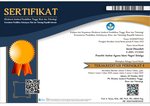The Figurative Meaning Of Metaphorical Expression In "Raja Ampat" Article On Indonesia,Travel Website
Abstract
Tourism is an essential element of modern life and modern society. Easy access to the internet facilitates the promotion of tourism spreading across the world. Through Indonesia.travel, the Ministry of Tourism of Indonesia official provides information about Indonesia tourism and travel. Raja Ampat, famous for its underwater destination, is one of the travel destinations highlighted on the website. Metaphorical expression frequently appears to describe Raja Ampat destination. This research focuses on observing how the language, specifically metaphor, is used in an article in Indonesia.travel entitled "Raja Ampat" to represent the nature of Raja Ampat as the travel destination. This study seeks to contribute to a better understanding of the role of metaphors in the mechanics of persuasion in promotional tourism discourse with a different approach, which is a semantic approach. The analysis metaphorical expressions to reveal the domains of tourism destination highlighted in the text are expected to shed light on how linguistics is closely related to various persuasion functions used in promotional tourism discourse. 13 metaphorical expressions found in the article. Source domain Building, Natural Landscape, High-Mobility, Religion, Family, Profession is utilized in metaphorical expression. It signifies that metaphor is used as a tool to bring the destination closer to travelers living in a city-situated environment.
Keywords : tourism, semantics, metaphor.
Full Text:
PDFReferences
Bastida, U., and Huan, T. C. 2014. Performance evaluation of tourism websites' information quality of four global destination brands: Beijing, Hong Kong, Shanghai, and Taipei. Journal of Business Research. 67, 2, 167-170
Dann, G. M. S. 1996. The Language of Tourism: A Sociolinguistics Perspective. UK, CAB International.
Dann, G. M. S. 2002. The tourist as a metaphor of the social world. UK, CABI Publishing.
Dann, G. M. S. 2002. Theoretical Issues for Tourism's Future Development, Identifying the Agenda. In Pearce, D.G., and Butler, R.W. Contemporary Issues in Tourism Development, London, Routledge.
Dann, G. 2012. Remodelling a changing language of tourism: from monologue to dialogue and trialogue. Revista de Turismo y Patrimonio Cultural. 10, 4, 59-70
Djafarova, E. and Andersen, H. (2008). The contribution of figurative devices to representation of tourism images. Journal of Vacation Marketing, 4(4), 291-303. Erjavec, K. (2004). Beyond Advertising and Journalism: Hybrid Promotional News Discourse. Discourse & Society, 15(5), 553-578.
Pragglejaz Group. (2007). MIP: A method for identifying metaphorically used words in
discourse. Metaphor and Symbol, 22(1), 1-39.
Fromkin, V., Rodman, R., & Hyams, N. (2010). An Introduction to Language.
Boston: Cengage Learning.
Jaworska, A., and Pritchard, A. 2005. Discourse, Communication and Tourism.
Clevedon, Channel View Publications.
Kennedy, G. (2016). Sosial Media: Master social media marketing. North
Charleston. Create Space Independent Publishing Platform
Mattiello, E. (2012). Metaphor in Tourism Discourse: Imagined worlds in English tourist texts on the web. Textus, 1(1), 67-82.
DOI: https://doi.org/10.18326/dinamika.v1i2.70-96
Refbacks
- There are currently no refbacks.
Copyright (c) 2021 Zefta Marcell Wijanarto









